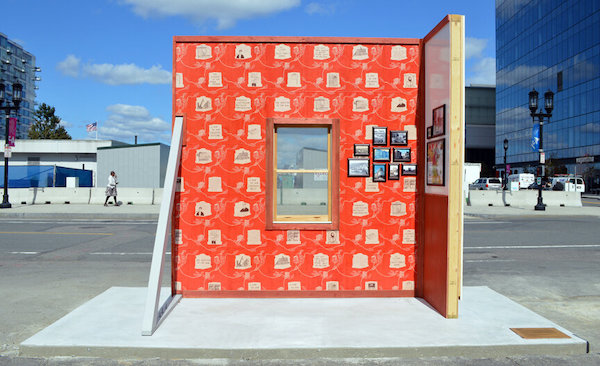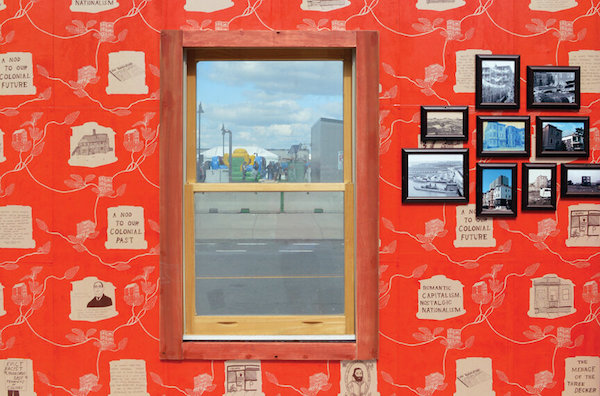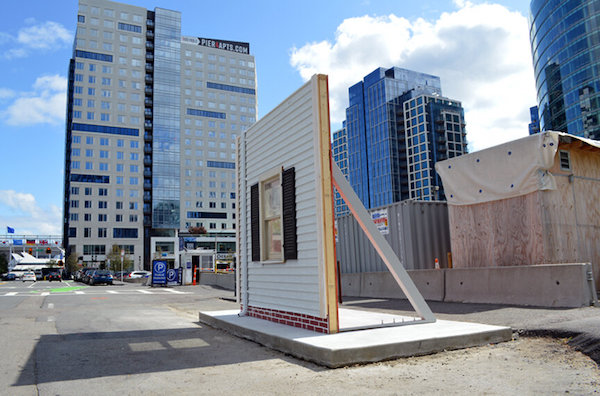Visual Arts Commentary: Pat Falco’s MOCK — A Resonant Statement about Boston’s Affordable Housing Crisis
By Mark Favermann
With MOCK, the artist has made an exceptionally powerful statement, conceptually and physically, about Boston’s increasingly dire affordable housing predicament.

MOCK Interior (2019) by Pat Falco, Photo by Pat Falco, copyright by Pat Falco, all rights reserved.
In order to attract tourists to Boston, the city has celebrated its rich history in various ways, from the nearly mythological to the gritty and the monumental. The Duck Boats sell out as magical history tours. Boston’s Freedom Trail is a triumphant path back to the past. Boston’s historic neighborhoods underscore the American city’s European character. However, throughout its long and venerated existence, Boston has been a city divided between the “haves” and “have-nots.” Immigrant populations have clashed with the Brahmin class, and its political leadership, for much of its history.
By the early 20th century, the Irish immigrants began to garner political power over the earlier English settlers. Newer groups hungry for influence followed as well (Italians, Jews, Portuguese, Southern Blacks, later on Haitians, Azoreans, Brazilians, etc.), and they were often met with barriers, hindrances, and downright discrimination. Unfortunately, prejudice against others was applied by those who, having come earlier, had been discriminated against themselves. This sad process can be seen in the history of the City of Boston’s housing policies, both official and unofficial.
Public housing, federal new housing construction policies after WWII, banks’ redlining, and individual bias added to a distasteful confluence of serious housing problems. Today, affordable housing in Boston is at a crisis level. This severely effects the lives of advanced guard urban pioneers, such as artists, as they fight to find living space in and around the city that they can afford.
We are a city in gentrification transition: an inequitable economy, the desperate need for lower income workers to access the city, the upwardly mobile re-dos of both traditional and new neighborhoods, booming construction and development projects. In his work MOCK, Pat Falco underlined the notion of social injustice by focusing on affordable housing as a metaphor for survival in the city. Challenging the bromides of city leaders, artist Falco brilliantly succeeded in making a visual statement that literally as well as figuratively called out Boston’s housing crisis. He drew on nostalgia to argue articulately in his art.

MOCK Interior Detail (2019) by Pat Falco, Photo: Falco, copyright by Pat Falco, all rights reserved.
MOCK, previously located at 109ish Northern Avenue (near Seaport Common), was a historically based, socially empathetic artistic intrusion; the structure was a tacky but very human statement in contrast to the Seaport District’s edifices made up of undistinguished glass and polished steel. It is Falco’s bow to the small-scale facade of a traditional Boston neighborhood triple-decker, many of which still stand in nearby South Boston. By placing it at the seaport, he established a contextual beachhead, a flag in the sand of time so to speak. In many ways, MOCK is a stunning aesthetic/political reaction to Boston’s building boom and affordable housing catastrophe.
Full-size mock-ups and large sample displays have become commonplace at construction projects in recent decades. At the beginning of construction of a project, architects will often direct contractors to provide material models for review. These mock-ups give the design and development team the opportunity to review material and color selections, and make modifications before product orders are placed. In a way, the mock-ups serve as gateways to a structure’s development. Provocatively, Falco introduced MOCK as a specific kind of gateway — for the consideration of affordable housing issues and long-term civic problems.
Samples often include paint, bricks, sections of cladding, window assemblies, masonry, roof treatments, etc. Alternatives or options are often exhibited side by side to enable judging of appearance and specification compliance. Testing allows for review of durability and efficiency. Falco cleverly makes use of these techniques in MOCK. He draws on a visual correlation for social and economic history to symbolically challenge an economically insensitive and dysfunctional present. In the second decade of the 21st century, the housing in the Seaport District is all about luxury; in the 19th and early 20th centuries triple-deckers were an aspirational necessity for the primarily immigrant working class.
Far from luxurious, these structures were a place where multigenerational families could live — grandparents, parents, and adult children with their own children. The three-story houses were family centers that could share often limited resources and encouraged family togetherness. Babysitters were available as well as caregivers for the elderly or ill. From this base structure developed aspirations for entering the middle class, and the desire to obtain a better education, higher income, and improved housing.

MOCK, in context of Boston’s Seaport District (2019) by Pat Falco, Photo by Pat Falco, copyright by Pat Falco, all rights reserved.
MOCK’s outside facade was appropriately ticky-tacky, with vinyl siding and faux brick foundation. My only criticism of these choices is that I feel the piece could have included a partial second and even a third story as well. A poet once said that the truth decorates a room. The interior of MOCK was about evoking the resonance of a time and place; the hand-painted wallpaper proffers early-20th-century working-class atmosphere while also commenting on Boston’s immigrant past. Attached to the covered walls were inexpensively framed historic photographs that displayed aspects of immigrant life and memories. Ironically, Falco ‘s mock-up presents these interior elements as if they were options for a modern design/building project. These were not simply vestiges of a very far from perfect past.
To be fair, after nearly three decades of development, Boston’s Seaport District now exhibits much more visual character and mixed-use development than its earlier incarnation as a series of slick but monotonous Kleenex-box structures, which still dominate the neighborhood. Still, Falco’s temporary public art installation underscored the point that a truly meaningful amount of affordable housing is an impossibility in the area. With MOCK, the artist has made an exceptionally powerful statement, conceptually and physically, about Boston’s increasingly dire affordable housing predicament. The structure’s artistic presence made its point through its backward-looking humility rather than overbearing imposition.
MOCK was sponsored by the Boston public art organization Now + There. Part of the organization’s Public Art Accelerator Program, it was located on Northern Avenue near Pier 4 Blvd. Mirroring the duration of a mock-up for a construction project, MOCK was only up for about two months (September 18 until November 29).
An urban designer and public artist, Mark Favermann has been deeply involved in branding, enhancing, and making more accessible parts of cities, sports venues, and key institutions. Also an award-winning public artist, he creates functional public art as civic design. Mark created the Looks of the 1996 Centennial Olympic Games in Atlanta, the 1999 Ryder Cup Matches in Brookline, MA, and the 2000 NCAA Final Four in Indianapolis. The designer of the renovated Coolidge Corner Theatre, he is design consultant to the Massachusetts Downtown Initiative Program. Since 2002, Mark has been a design consultant to the Red Sox. Mark is Associate Editor of Arts Fuse.
